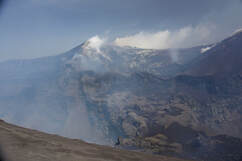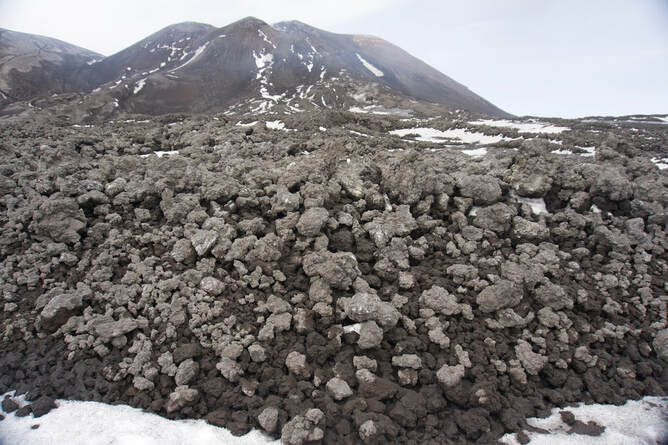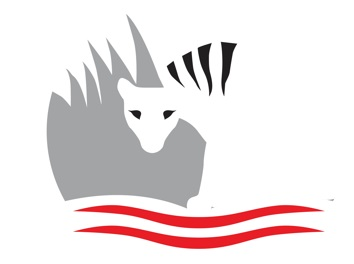 Mt Etna (or Mongibello in Sicilian) is one of the best known and respected volcanos on our planet. It is the highest active volcano in Europe, outside the Caucasus, currently 3,326m high, though this varies with summit eruptions. Etna covers an area of 1,190 km2 with a basal circumference of 140 km. Mt Etna also is one of the world’s most active volcanoes and is in an almost constant state of activity. Volcanic activity first took place at Etna about 500,000 years ago, with eruptions occurring beneath the sea off the ancient coastline of Sicil  Etna is listed as UNESCO World Heritage Sites, so its position as top dog of the European volcano scene is well established, particularly compared to relative latecomers like that unpronounceable Icelandic one that grounded flights a few years ago. And after all, how many pizza restaurants around the globe are called Eja@^%#$^@$#jukull?? With ITIKI securely moored on the Siracusa Town Quay (did I mention its free, except €10 for garbage collection, if you’re around when they come by…) and with Etna only 90 mins drive away, how could we resist a visit?! We managed to hire a car for 24 hours with limited drama and gesticulation and booked our tour for the next day. Of course, we have chosen the full experience to go all the way to the main crater. We arrive to early meet our guide, the lovely Nico, and get kitted up with hiking poles and helmets(?!), but opt to use our own shoes. Our trek starts at 1,900m and the first stage is a relatively easy walk through the car park to the Funivia (or cable car) which then takes us up to 2,500m. Next its straight on to 4WD buses for a hair-raising ride up to 2,920m to begin our trek to the main crater. It’s going to take us about 1.5 hours to get up to the crater so we head off straight away. The first section is a gently slope across a lava field with mud, snow and snowmelt across our path. Not too challenging so far, but the breeze is cool and the altitude is definitely noticeable. We stop for morning tea after about 30 minutes before donning our helmets and starting our climb. The next part is the toughest as we navigate a steep and narrow path, traversing mud and snowmelt, making our way around the side of the peak before zig-zagging back again to climb higher. We stop every 20 minutes or so to catch our breath. Not sure if we can blame the altitude, our respective ages, recent lack of match fitness, the cold or all of the above however this is feeling a whole lot tougher than it should be! Keith admitted to feeling like a 70 year old - I don’t know where he thinks he is going to get one on the side of Mt Etna!? I just need a bit more oxygen! Finally we reach the rime (ie the rim) of the central crater, at 3,230m. I will mention at this point that our guide Nico is very knowledgeable and speaks very good English, with a very strong but gorgeous Italian accent (actually he is quite cute too…) He explains that there are currently five distinct craters — the Northeast Crater, the Voragine, the Bocca Nuova, and the Southeast Crater Complex (2 craters). Eruptions can occur here but also on the flanks, which have more than 300 vents ranging in size from small holes in the ground to large craters hundreds of metres across. The crater area here is enormous and obviously very deep. The summit is in front of us and there are some climbers making their way around the rim towards it. The sight of the crater is one thing to try and capture in photos, however the sounds and the smells are something else. Nico sushes us for a moment. Yes you can hear the wind on the mountain, but under that there is also the rumbling of the volcano and the muffled banging of small explosions within the mountain, like approaching thunder. The earth is alive and speaking to us from her very core! Then there is the smell – there are clouds of steaming gas swirling from the crater and from vents in the ground around us. The smoke is acrid and bitter and burns your throat. Everyone starts coughing at the same time, and I try to wrap my scarf around my face. The wind is really freezing up here, even though the ground beneath us is warm underfoot. We move around the crater rim further as Nico talks about the history of Etna, its initial formation and recent explosions. Since 2000, Etna has had four flank eruptions — in 2001, ‘02–‘03, ‘04–‘05, and ‘08–‘09. Summit eruptions occurred in 2006, ‘07–‘08, Jan–Apr ‘12, in Jul–Oct ‘12 and again in Dec ‘18. While we did not see any hot rocks or lava flying out of the volcano it was an incredible to see, smell and feel this powerful mountain. We head down via a different route and the decent is even more challenging with soft scree, mud and gravel. It’s a matter of digging in your heel and sliding down until you stop before taking the next step. The poles come in handy to get some balance, however my shoes are rapidly filling with Etna’s emissions. Rather than taking the 4WDs back down we will walk to the top of the Funivia as this allows us to check out another older crater which is facing down towards the village we passed through on the way up. There were some lava flows from this crater just 2 years ago! The village was not in danger though. More sliding down through scree and snowfields before we finally reach the Funivia, so good to sit down! We are both absolutely knackered but what an amazing experience to visit Mt Etna, one we will not easily forget!
0 Comments
Leave a Reply. |
AuthorAfter more than 5 years of (minus time off for Covid) and more than 27,000nm Lynda has finally got the hang of this cruising life Archives
June 2024
Categories |

 RSS Feed
RSS Feed
